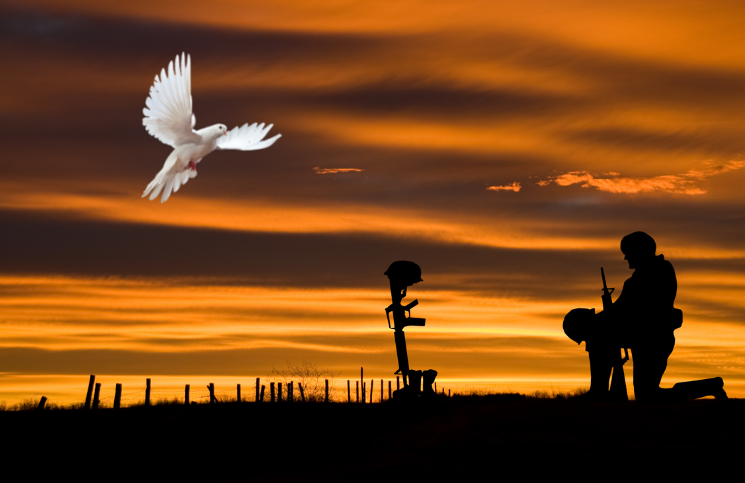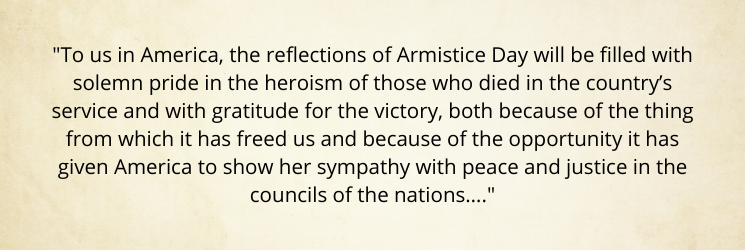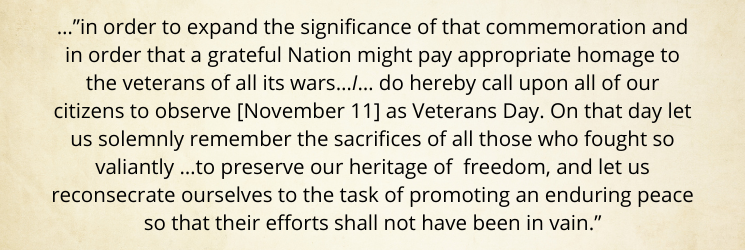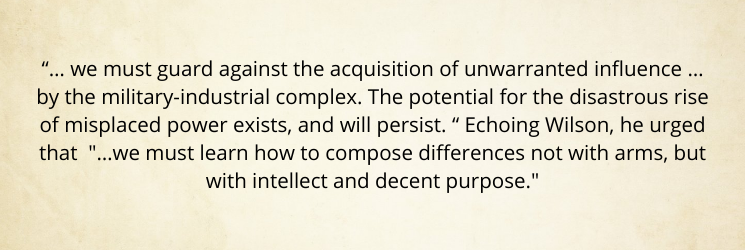by Gary Kaplan
On November 11, 1919, President Woodrow Wilson proclaimed “Armistice Day” in commemoration of the signing one year before of the ceasefire that silenced the guns of The Great War. His proclamation read:
It is significant that his statement recognized the veterans, passed quickly over “the victory,” and dilated on the vision of international cooperation for peace he had essayed in his Fourteen Points and would soon embody in the Covenant of the League of Nations, his great cause. He intended Armistice Day to be a celebration of peace, not war. He hoped to ensure that the Great War in which 20 million had died would pass into history as “the war to end all wars.”
The United States did not join the League of Nations. Thirty-five years later, in 1954, President Eisenhower issued a proclamation acknowledging that since 1919 “two other great military conflicts [had] added millions of veterans to the honor rolls of this Nation.” The proclamation noted Wilson’s Armistice Day hopes and echoed his language:
Eisenhower was referring to the 16 million veterans of World War II and 1.8 million veterans of the Korean War. Since then, the commemorative scope of Veterans Day has expanded further to include 9 million Viet Nam veterans, 650,000 Gulf War veterans, 1 million Iraq veterans, and 980,000 veterans of Afghanistan.
War has never been popular in the United States. Only 45% of the colonial population supported the War of Independence and Washington had constant difficulty persuading the Continental Congress to provide funds to feed and equip his troops. Despite, or perhaps because of, his lifelong military career, in his farewell address of 1796 he warned against involvement in foreign wars, a position that would develop into ingrained isolationism.
Even the “good war,” World War II, was not popular before December 7, 1941. Despite the German occupation of most of Europe and widespread knowledge of Hitler’s atrocities, our isolationist Congress refused to get involved in a foreign war, as Washington had cautioned. Only the attack on Pearl Harbor jarred loose a declaration of war.
Our most recent former-general president, Dwight D. Eisenhower, updated Washington in his farewell address of 1961 with a warning against domestic militarism:
But war has a way of overwhelming intellect and decent purpose. Our culture has glorified war since the Iliad and the Aeneid. Our oldest heroes, Odysseus and Aeneas, were warriors. Our literature and art are full of the heroism of war. General George S. Patton, a hero of WWII and 20th Century Fox, explained why: “Compared to war, all other forms of human endeavor shrink to insignificance. God help me, I do love it so.”
War affects everyone, combatants and non-combatants. It totally consumes a society.
World War II became the dominant myth of US history. General Eisenhower, the Supreme Allied Commander in Europe, was president from 1953 to 1961, the definitive period of the American Imperium. History crystallizes into myth. Movies about our GI heroism were made throughout the ‘50s, ‘60s and ‘70s and are still being made (Greyhound with Tom Hanks, 2020). John Wayne will forever fight his way across Nazi-occupied Europe and through the jungles of the Pacific. The WWII myth still has the power to reactivate the unifying memory of the 1940s. It still can unite virtually all Americans, at least through the Baby Boom generation.
If World War II united Americans, Viet Nam divided them, not just between generations but within generations. The march on the Pentagon in the fall of 1967 dramatized the intra-generational schism. The National Guardsmen were in military uniform with guns. The protesters were in counterculture uniform with beads. The protesters were lined up a few yards from the Guardsmen who were pointing rifles at them. In a famous photo, a protester steps forward and the Guardsman makes a menacing gesture with his gun. The protester reaches out his arm and inserts a flower in the gun barrel. The two kids are the same age, maybe 19 or 21. One has long hair, the other short. Otherwise, the same kid. Why were they at odds? Where was the unity of 1945?
The war in Viet Nam fractured the country along all its deep fault lines of race and class. World War II had united the country and taped over those fault lines for two decades. Viet Nam ripped the tape off and splintered the orthopedically stabilized body politic. Today’s cultural and political divisions along lines of class, race, income and education are the same as in the 60s and 70s, but deeper. Poor and working class Black and Hispanic and white kids went to Viet Nam and if they did come back, they defended the war they fought in. Rich kids avoided the draft with student deferments, marched against the war, and looked down on the war-weary veterans who came back from the jungle with wounds visible and invisible. The cultural divisions of those days have metastasized into the polarized cleavage of today.
There are now about 21 wars going on around the world. All industrial countries have vital economic and strategic interests everywhere in the global supply chain. The US has 750 military bases in 80 countries to protect ours. Someone sometime will threaten our interests enough that we will have to push them back. Then we will have another cohort of veterans.
Washington, Wilson and Eisenhower knew the double-edged sword of military action all too well. Washington and Eisenhower were battle-scarred veterans. They all honored veterans, as we do today, but not as Homer and Vergil did. Rather than glorify deeds of combat and martial victory, they defined peace as the ultimate purpose of military action. In honoring veterans, they made their service to the pursuit of peace the highest form of praise. We join them today.
Gary Kaplan is the executive director of JFYNetWorks.
HOW ARE WE DOING? In our pursuit to serve up content that matters to you, we ask that you take a couple of minutes to let us know how we’re doing? Please click here to be navigated to our JFYNet Satisfaction Survey. Thank you!








